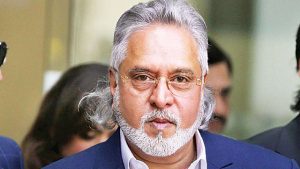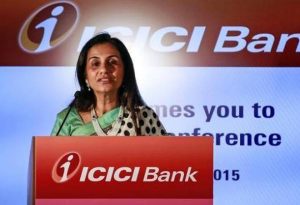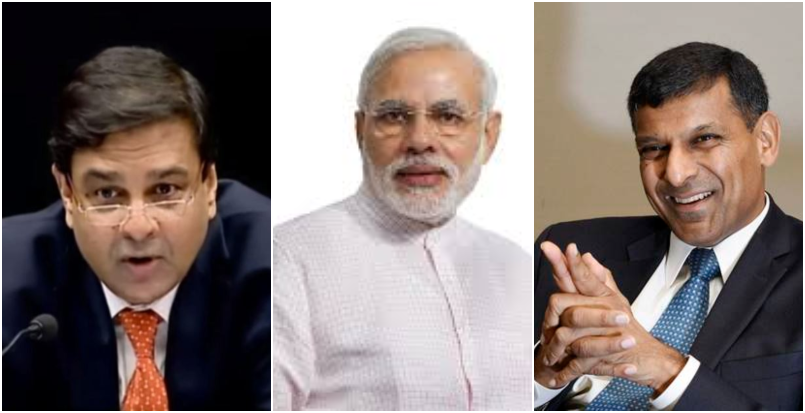BULLYING: After refusing to extend the term of Dr Raghuram Govind Rajan for opposing demonitisation, Narendra Modi is trying to bully Reserve Bank Governor Urjit Patel to relax the controls on corrupt banks extending loans to corrupt businessmen. (l to r) Urjit Patel, Narendra Modi, Raghuram Rajan
By P Vaidyanathan Iyer
Incumbent RBI governor Urjit Patel faces unprecedented challenges. There is a dispute raging between the bank and the government on issues ranging from lending curbs to who controls the institution’s reserves. The government even invoked never-before-used powers under the RBI Act that allow it to issue directions to the central bank governor on matters of public interest
No. No, no, no, no. No, no, no. Yes. No, no, no.” This was a Reserve Bank of India governor on one end of a telephone call responding to someone. Curiosity got the better of a gentleman — incidentally there to call on the governor. He couldn’t resist asking who the person at the other end was. “The Finance Minister,” said the governor. The gentleman wondered aloud, not about the many ‘noes’, but the single ‘yes’. The governor replied, “In between, the Finance Minister asked me if I even heard him. I said ‘yes’.”
The RBI governor, the then finance minister, and the gentleman witness to this conversation will remain unnamed; all three are well-known personalities in public life. But the short point of the even shorter conversation illustrates the most critical aspect of the RBI-government relations: they are, and have always been, tenuous and complex, but the two must find ways to communicate and work together. When this communication breaks down, one has to eventually give way. And this cannot happen in the India of today.
The genesis of central banking in India and its history since the formative years of 1935-39 published by the Reserve Bank of India is replete with instances of differences with the government. In independent India, only once, in 1956-57, has the RBI governor had to quit. Interestingly, then too, as now, the fight centered around credit flow to various sectors of the economy — between the RBI’s ‘restrictive policy’ and the government’s ‘liberal’ stance. Then FM T T Krishnamachari made little secret of his views about the RBI’s stance. Then RBI governor Benegal Rama Rau stepped down, on January 14, 1957, after the Cabinet, under PM Jawaharlal Nehru, backed Krishnamachari. Rama Rau, an Indian Civil Service officer with a distinguished career, who had been the RBI governor for over seven years, chose not to speak publicly about the spat ever.
Apart from this, R N Malhotra and K R Puri have resigned as RBI governors following change of government at the Centre in 1990 and 1977, respectively.
India’s tectonic shift in policy-making and consequent high growth over the past three decades have also had a profound impact on regulator quality. In 2000-01, the size of the Indian economy was under $500 billion. By mid-2007, output doubled to a trillion dollars, putting the country among the top 10 economic powerhouses in the world. At $2.5 trillion now, India is the sixth largest economy in the world, and the fastest-growing too.
Economic regulators, and their real as well as perceived autonomy, influence flow of capital from the rest of the world to India, and add to its heft at the global round table. Not surprising then that the IMF said Thursday, “There should be no government or industry interference that compromises the independence of the central bank and financial supervisor.”
Historical RELATIONSHIP
Amidst turbulent times between RBI governors and the government over the past 25 years, channels of communication have never broken down. Sometimes, the Prime Minister himself has weighed in, like Atal Bihari Vajpayee did during the East Asian crisis to rein in Cabinet colleagues who were commenting on the strength of the rupee. At other times, for instance, during the 2008 global financial crisis, then deputy chairman of the Planning Commission Montek Singh Ahluwalia, who commanded respect both in Delhi and Mumbai, worked the backchannels with the RBI governor for the government.
Since liberalisation, there have been probably just two FM-RBI governor pairs whose co-tenures have been characterised by tranquillity, i.e., maximum respect, minimal friction. FM Manmohan Singh (1991-96), and Governor C Rangarajan (1992-97); and FM Yashwant Sinha (1998-2002), and Governor Bimal Jalan (1997-2003). Of course, once Manmohan Singh became PM in 2004, Rangarajan became his go-to person for solving tricky issues such as gas pricing or politically sensitive ones like the development of Jammu and Kashmir. Jalan came in at the RBI four months into the East Asian crisis, when the rupee was under tremendous pressure in the face of sanctions over the Pokhran nuclear tests. He mustered courage, flew to Delhi and asked PM Vajpayee to prevail upon his Cabinet colleagues to stop commenting on the strength of the rupee. When Vajpayee did so, it provided Jalan the space to keep the markets guessing about the timing of the RBI’s intervention in the forex market, and the flexibility to let the rupee relax beyond an informal band with sparse use of forex reserves.
These were exceptions. The relations in the times of P Chidambaram-Y V Reddy (2003-08); Chidambaram and Pranab Mukherjee-D Subbarao (2008-13); Arun Jaitley-Raghuram Rajan (2013-16); and Jaitley and Piyush Goyal-Urjit Patel (now), have been frosty.
In October 2012, RBI Governor Subbarao had belied FM Chidambaram’s expectations of a rate cut in his second quarter policy review, despite the latter unveiling a five-year fiscal consolidation plan the previous day. Clearly cut up, the minister had said, “Growth is as much a challenge as inflation. If the government has to walk alone to face the challenge of growth, then we will walk alone.” A week before his term ended, Subbarao shared his thoughts on accountability and autonomy in a lecture and said, “I do hope… Chidambaram will one day say, ‘I am often frustrated by the Reserve Bank, so frustrated that I want to go for a walk, even if I have to walk alone. But thank god, the Reserve Bank exists.’”
Reddy, who had preceded Subbarao, too had put up stiff resistance to the government on many an issue, including loan waivers to farmers and reforms in the financial sector.
In arriving at a middle path, a lot also depends on the personalities of the minister and governor. A sharp and extremely intelligent minister, Chidambaram was known to be impatient and demanding. Reddy was also known to stick to his views, and say no when not convinced, but he avoided open conflict.
Recounting the time he was summoned by PM Manmohan Singh to his residence on a Sunday in early 2008, Reddy writes in his autobiography, Advice & Dissent: My Life in Public Service, “He said, ‘Venu, the FM is very upset with you. I do not know what to do. I cannot be taking sides between Chidambaram and you’. I responded, ‘Sir, you have many worries… You please take care of your health. You need not bother about this problem. I will take care of my relations with the minister’.” Reddy adds he went straight to Chidambaram’s house, offered unconditional apology, and said he would keep in mind the need to be supportive.
Rajan & Patel: The outsiders
With his formidable reputation as IMF Chief Economist, Raghuram Rajan had really pushed the envelope as RBI governor, giving unsolicited advice to the Modi government on many occasions. On December 2, 2014, he had picked holes in the government’s flagship ‘Make in India’ programme. Rajan had cautioned against focusing on just one sector such as manufacturing, just because it had worked well for China. Again, while Cabinet ministers were revelling in talking up India as the fastest growing economy in April 2016, Rajan had said at a convocation address at the National Institute of Bank Management in Pune, “Speaking to a foreign journalist the other day, who asked what it felt like to be the bright spot in the world economy, I used the phrase ‘Andhon mein kaana raja (In the Land of the Blind, the one-eyed man is king)’.” Rajan had added, “As soon as we believe in our own superiority and start distributing future wealth as if we already have it, we stop doing all that is required to continue growing.”
When ministers expressed their anger, Rajan apologised, but only at the possibility of having offended the visually impaired

with his phrase.
Some of Rajan’s predecessors note in private that many issues Rajan spoke his mind on were not in his remit. On February 20, 2015, still in the first year of the Modi government, Rajan, speaking on Democracy, Inclusion, and Prosperity at the D D Kosambi Ideas Festival in Goa, said he was discarding his RBI hat to speak as a professor on political economy. While not referring to the Modi government, he spoke of how strong governments may not move in “the right direction”. “Hitler took Germany efficiently and determinedly on a path to ruin, overriding the rule of law and dispensing with elections.” When the government had not extended Rajan’s three-year tenure, few had been surprised.
Sources say Jaitley preferred Arvind Subramanian, who was serving as Chief Economic Advisor, as Rajan’s successor. But Modi picked Urjit Patel, who had been Rajan’s deputy. Within two months, Patel faced the first challenge with Modi’s demonetisation decision. While past governors such as Jalan, Reddy, Subbarao as well as Manmohan Singh accused the RBI of not doing enough to mitigate public distress, Patel also had to face gruelling questions from parliamentary committees on the withdrawal of currency notes.
That Patel was bruised is evident from a mail he wrote to RBI employees on New Year’s eve. Referring to demonetisation, he wrote, “Let me emphasise that one thing we should all zealously guard is the integrity and reputation of our organization and any act belittling the same should deserve zero tolerance….”
This appears to have been the beginning of the souring of relations between Patel and the government. In June 2017, when the Finance Ministry sought to make a presentation to the monetary policy committee (MPC) ahead of its meeting on June 6-7, Patel asserted the central bank’s independence. On June 8, he told the media that the MPC had declined the ministry’s request.
When the RBI did not cut rates after this MPC meeting, Subramanian launched an offensive on the RBI’s inflation forecasting methodology — though forecasting is a dicey business. Bibek Debroy, Chairman, Prime Minister’s Economic Advisory Council, did try to work the backchannels between the government and the governor, but without much success.
Patel’s self-effacing mannerism also invited barbs from Mumbai finance veterans since he did not seek intelligence from outside. However, it also got him accolades from traditionalists for keeping market players at bay.
In the RBI ranks, Deputy Governor Viral Acharya is one person with whom Patel interacts frequently, an insider says. Some other deputy governors have apparently got replies in form of scribbles on note slips they passed on. “Every governor is different… You have to accept that,” says a former deputy RBI governor, who has interacted with Patel.
A circular on February 12, 2018, by the RBI also underlined the rift. In case of defaults `2,000 crore and above, the circular asked banks to finalise a resolution plan, failing which insolvency proceedings were to be pressed against the defaulting company. This specifically affected power sector players whose projects were stuck for no fault of their own, such as late regulatory clearances and payment delays by distribution companies. While the government was keen that the circular be withdrawn, the RBI did not relent.
Over the following period, while official communication between the Finance Ministry and RBI collapsed, there were hardly any informal channels. The appointment of S Gurumurthy, a person with a strong political ideology, to the Central Board of the RBI in August, followed by the removal of banking expert Nachiket Mor, only left the RBI even more exasperated. The Board, stocked with stakeholders from different segments of the economy, had for long been a dormant body quietly nodding in agreement with the RBI. Not anymore. They persistently asked questions and even demanded reversal of decisions.
A source familiar with these developments said, while it is true that RBI has to take a long-term view, at times, it has to also check the weather of the moment. One example of Patel’s aversion to meeting market players even during crisis was his unwillingness to grant audience to the NBFCs facing a liquidity crisis, which brought the players knocking at the doors of the NITI Aayog and North Block. Gurumurthy demanded more credit and relaxation for the micro, small and medium enterprise (MSME) segment, which is a strong vote base of the BJP. He pushed for relaxation of the prompt corrective action framework that currently restricts lending by 11 banks since their financial parameters — capital adequacy, net non-performing assets and return on assets — had breached trigger points.
All of this formed the background to the RBI outburst late last month. On October 26, Deputy Governor Acharya publicly warned that “Governments that do not respect central bank independence will sooner or later incur the wrath of financial markets…, and come to rue the day they undermined an important regulatory institution.”
A former RBI governor, who did not wish to be named, said if Patel was so frustrated, he should quietly step down as governor. Even before Acharya’s address, the Finance Ministry had invoked Section 7 of the RBI Act that allows the government to call for consultations with the governor as a first step on issues of ‘public interest’. If the RBI does not agree with the government post consultations, the Centre can issue a directive forcing the governor’s hand. The former RBI governor says Patel has placed himself in a piquant situation. “He can’t quit now having taken the war for independence and autonomy public, and staying on will require restraint not just on his part, but also the government’s.”
That doesn’t seem likely. On Friday, PM Modi announced cheaper credit to small businesses on fresh loans, explicitly using the fiscal instrument of interest subsidy to bypass the RBI, that is loath to MSME forbearance and relaxation of bank lending norms.
What next
‘
Path dependence’ is a term often used in economics. According to the Financial Times Lexicon, it is an idea that decisions we are faced with today depend on past knowledge trajectory, and are thus limited by the current competence base. In other words, history matters for current decision-making situations and has a strong influence on strategic planning. India’s politics since 1984 with coalition governments at the Centre offers little guidance to the RBI on dealing with a government which came to power with absolute majority in May 2014. The government led by PM Modi believes in the concept of a strong

sovereign — the nation’s sovereignty takes precedence over the autonomy of RBI and all other institutions.
But in the last three decades, as India charted an irreversible path of opening up to the global economy, salient aspects of the developed democracies such as accountability and respect for institutions are taken for granted. That be true, both Urjit Patel and Raghuram Rajan stand out in the post-liberalisation club of RBI governors. They are new to the entrenched and normatively stodgy bureaucracy of the government and also of the monolithic RBI.
This is a government that often wears power on its sleeve. Rajan’s reflections on political, social and economic issues struck discordant notes in the government. The best it could do was not extend his tenure. If Rajan spoke a lot, Urjit Patel is at the other end of the spectrum. He has developed his own language, and for most times, he lets his actions speak. The craft and tactfulness of the governor will, therefore, be tested as he seeks to preserve RBI’s authority, autonomy and independence vis-à-vis the government and its political imperatives in the months leading up to national elections.
Courtesy: Indian Express
